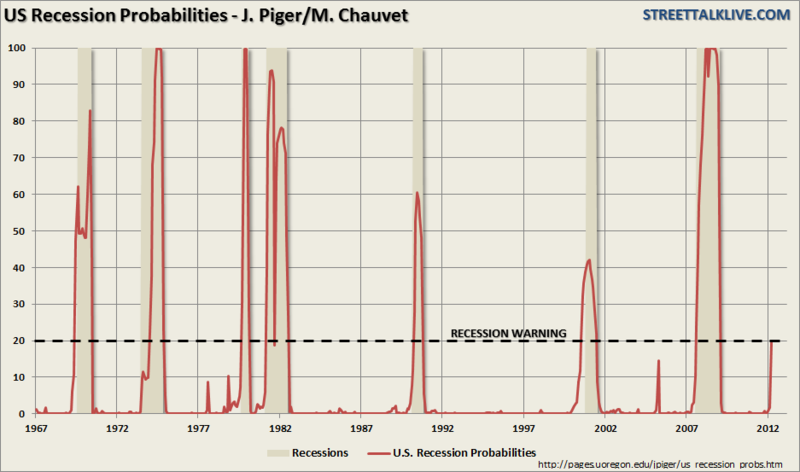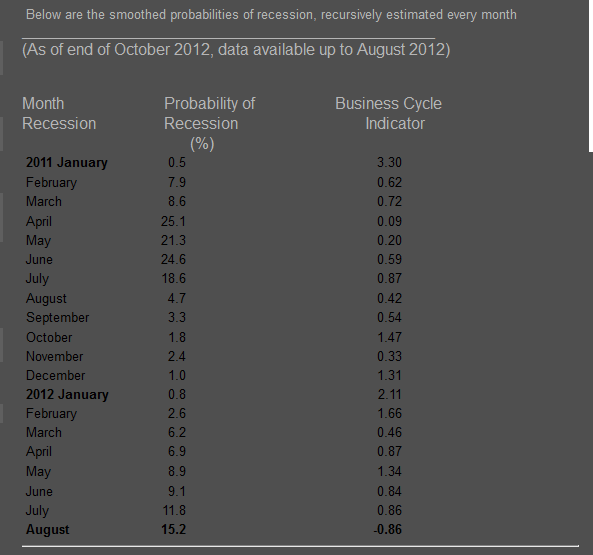Note to readers -- It was either this topic or the fiscal cliff. Since I have explained for many weeks that we will not be doing any cliff diving, I am choosing to take up the recession chart. So much misleading commentary, and so little time!
This chart is making the rounds, confirmation bias for those who are convinced that below-trend growth equals a recession.
There are several leading sources pointing to the chart and suggesting that it implies a 100% chance of a recession. There are so many things wrong with this that I hardly no where to begin. Here is the commentary from non-economist talk-show guy Lance Roberts:
"As stated above, each time this indicator has signaled the probability of a recession at 20%, or higher, the economy has either been in, or was about to be in, a recession. However, while the indicator is currently at a level that is indicative of a recession, along with a host of other economic indicators confirming the same (LEI Coincident to Lagging Ratio, ADS, GDI, Final Sales, STA Economic Composite, etc.), the NBER will wait to date the recession until the data revisions are in. Historically, as shown in the table below, the amount of time between the recession probability indicator hitting 20% and the NBER confirming the start of the recession has been on average about eight months. However, since the turn of the century that lag has moved to roughly 11.5 months."
Try this. Suppose that your favorite football team has not lost a game in the last three years in which it has scored 24 points or more. Then they lose 27-24. You simply revise the proposition to say that they have never lost when scoring 27 or more points. This is what many amateurs do in interpreting data like the chart above.
Look at the chart above and pretend that we were going back to the future in 2005. You could have drawn the line at 15% and said everything that Lance says now. You would have been completely wrong!
This "never before" style commentary keeps coming up. It has no solid basis in research methods, but it seems convincing to anyone who has not studied research methods.
A Novel Idea -- Read the Research! D'oh
Here is a novel idea for the economic bloggers -- count to 10! Maybe you should actually read the research and consult with the authors before rushing to publish.
If you actually read the cited paper you would see the following points:
- The authors were trying to improve slightly on the NBER recession dating process -- getting closer to real time.
- The authors recommended waiting until a reading of 80% was reached for three consecutive months to avoid excessive false positives. (P. 9 of the paper)
Why the Average Investor is Getting Bamboozled -- Again!!
This is interesting research. My strong recommendation is that interpreting a complex economic paper should involve the opinion of the authors. I strongly doubt that any of the pundits writing about this could speak coherently for thirty seconds about Markov models. So why should we listen to them?
I called Prof. Piger yesterday afternoon (voicemail), and I'll try again. Meanwhile, I am accepting his work at face value. It is a tiny and preliminary recession warning. I will be quite surprised if he agrees with the Lance interpretation of his work.
About eighteen months ago I initiated a challenge to the ECRI as the top recession forecaster. At the time, they were not forecasting a recession, but I was concerned about the methodology. I invited nominations from everyone, and regularly highlight those with the best records. (Anyone who has followed my approach has done well in the market over the last eighteen months).
My highly visible search has helped me to discover an expert community in recession forecasting. We have regular discussions. I frequently highlight the excellent articles by these colleagues.
I want to preserve the privacy of these emails, while still giving credit. To this end let me say that Dwaine Van Vuuren of RecessionAlert, one of my regular featured sources, suggested to me that the published chart does not reflect original data.
That got me thinking, so I checked out Prof. Chauvet's site. Sure enough, the data from last year shows a spike which apparently was later revised away if you believe Prof Piger's site.

Note the serious discrepancy with Piger.
Here is the supporting data:

Dwaine tells me that this is common with Markov models and revisions. I hope that he will write on this topic, and that he will gain the wide visibility he deserves.
Investment Conclusion
Today's market was a combination of the following:
- Investors confusing their politics with their investing;
- Excessive fear about the fiscal cliff;
- Excessive fear about Europe; and
- Those mesmerized by "the chart" discussed here.
I'll try to cover the fiscal cliff issues soon, but you already know my conclusion.
